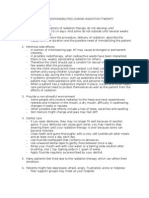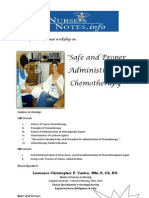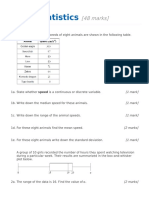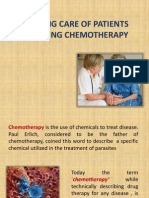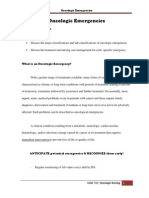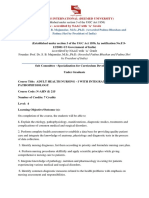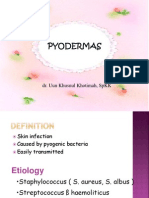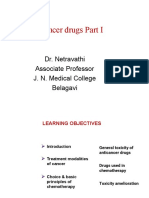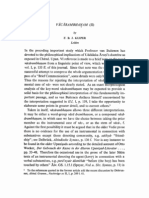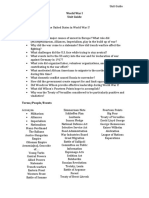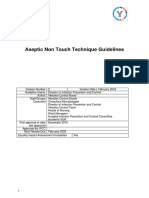100%(3)100% found this document useful (3 votes)
5K viewsChemotherapy PPT
Chemotherapy PPT
Uploaded by
Jaylord VerazonThis document discusses chemotherapy and provides guidelines for oral and IV chemotherapy. It begins with learning objectives about cancer treatment and chemotherapy. It then defines chemotherapy and discusses its purposes and types of agents. The document outlines the oncology team and describes chemotherapy's goals of damaging cancer cells while sparing healthy cells. It provides safety guidelines for oral and IV chemotherapy administration and handling to prevent exposure. The summaries focus on chemotherapy's purpose and mechanisms along with safety guidelines for administration and handling.
Copyright:
© All Rights Reserved
Available Formats
Download as PDF, TXT or read online from Scribd
Chemotherapy PPT
Chemotherapy PPT
Uploaded by
Jaylord Verazon100%(3)100% found this document useful (3 votes)
5K views58 pagesThis document discusses chemotherapy and provides guidelines for oral and IV chemotherapy. It begins with learning objectives about cancer treatment and chemotherapy. It then defines chemotherapy and discusses its purposes and types of agents. The document outlines the oncology team and describes chemotherapy's goals of damaging cancer cells while sparing healthy cells. It provides safety guidelines for oral and IV chemotherapy administration and handling to prevent exposure. The summaries focus on chemotherapy's purpose and mechanisms along with safety guidelines for administration and handling.
Original Description:
Ff
Original Title
Chemotherapy PPT_17b1fe257cc4102709af6ef42fda68e0
Copyright
© © All Rights Reserved
Available Formats
PDF, TXT or read online from Scribd
Share this document
Did you find this document useful?
Is this content inappropriate?
This document discusses chemotherapy and provides guidelines for oral and IV chemotherapy. It begins with learning objectives about cancer treatment and chemotherapy. It then defines chemotherapy and discusses its purposes and types of agents. The document outlines the oncology team and describes chemotherapy's goals of damaging cancer cells while sparing healthy cells. It provides safety guidelines for oral and IV chemotherapy administration and handling to prevent exposure. The summaries focus on chemotherapy's purpose and mechanisms along with safety guidelines for administration and handling.
Copyright:
© All Rights Reserved
Available Formats
Download as PDF, TXT or read online from Scribd
Download as pdf or txt
100%(3)100% found this document useful (3 votes)
5K views58 pagesChemotherapy PPT
Chemotherapy PPT
Uploaded by
Jaylord VerazonThis document discusses chemotherapy and provides guidelines for oral and IV chemotherapy. It begins with learning objectives about cancer treatment and chemotherapy. It then defines chemotherapy and discusses its purposes and types of agents. The document outlines the oncology team and describes chemotherapy's goals of damaging cancer cells while sparing healthy cells. It provides safety guidelines for oral and IV chemotherapy administration and handling to prevent exposure. The summaries focus on chemotherapy's purpose and mechanisms along with safety guidelines for administration and handling.
Copyright:
© All Rights Reserved
Available Formats
Download as PDF, TXT or read online from Scribd
Download as pdf or txt
You are on page 1of 58
At a glance
Powered by AI
The key takeaways are that chemotherapy is a systemic treatment used to destroy rapidly growing cancer cells. It can be used alone or in combination with other therapies like surgery and radiation. The document discusses the types and purposes of chemotherapy as well as potential side effects and nursing considerations.
The three main types of chemotherapy treatment discussed are neoadjuvant chemotherapy, adjuvant chemotherapy, and palliative chemotherapy.
Some potential side effects of chemotherapy discussed include vascular issues, pulmonary issues, reproductive/sexual issues, and psychiatric issues.
NCM 112- RLE
Care of Clients with Problems in Oxygenation, Fluid and
Electrolytes, Infectious, Inflammatory & Immunologic Response,
Cellular Aberrations, Acute & Chronic
PREPARED BY:
ANNE MARGARET C. BOTOR, RN
Chemotherapy
Learning
Objectives
Learning Objectives
1. Discuss cancer and its treatment modalities
2. Define chemotherapy
3. Enumerate the purposes of chemotherapy
4. Discuss the functions of the oncology multidisciplinary team
5. Describe the types of chemotherapeutic agents
6. Discuss the possible side effects of chemotherapy and its nursing
considerations
Brief Background on
Cancer
Cancer
A disease caused when cells divide
uncontrollably and spread into surrounding tissues.
Cancer: Causes
Cancer arises from the transformation of
normal cells into tumor cells in a multi-stage process
that generally progresses from a pre-cancerous
lesion to a malignant tumor. These changes are the
result of the interaction between a person's genetic
factors and three categories of external agents,
including:
1. Physical carcinogens- Radiation, asbestos
2. Chemical carcinogens- Cigar, alcohol
3. Biological carcinogens- EBV, steroid hormone
Oncology
A branch of medicine that deals with the
prevention, diagnosis, and treatment of cancer.
Oncology Multidisciplinary Team
1. Medical oncologist
2. Surgical oncologist
3. Radiation oncologist
4. Oncology nurse
5. Oncology social worker
6. Patient navigator
7. Psychiatrist
8. Dietitian
9. Home health aide
10. Pharmacist
11. Clergy
Cancer Treatment
Modalities
Local Therapy
a. Surgery
Local Therapy
b. Radiotherapy
Systemic Therapy
a. Hormonal therapy
b. Immunotherapy
c. Biological therapy
d. Chemotherapy
Chemotherapy
Chemotherapy
Chemotherapy is an aggressive form of
chemical drug therapy meant to destroy rapidly
growing cells in the body.
Chemotherapy is a systemic treatment and is
often used in combination with other therapies, such
as surgery, radiation, or hormone therapy. The use of
combination therapy depends on:
1. The stage and type of cancer
2. Overall health
3. Previous cancer treatments
4. Location of the cancer cells
5. Personal treatment preferences
Types of Chemotherapy Treatment
1. Neoadjuvant Chemotherapy- Delivered before
surgery with the goal of shrinking a tumor or stopping
the spread of cancer to make surgery less invasive
and more effective.
2. Adjuvant Chemotherapy- Administered after
surgery to kill any remaining cancer cells with the
goal of reducing the chances of recurrence.
3. Palliative Chemotherapy- Treatment designed
for terminal cancer patients to prolong survival and
ease symptoms but not cure disease.
Goal of Chemotherapy
The aim of chemotherapy is to do the maximum
damage to cancer cells while causing the minimum
damage to healthy tissue.
Chemotherapy Uses
1. Lower the total number of cancer cells in the body
2. Reduce the likelihood of cancer spreading
3. Shrink tumor size
4. Reduce current symptoms
5. After surgery or remission, to remove any remaining
cancer cells and delay or prevent a recurrence
6. To slow disease progression and reduce symptoms
in the later stages, even if a cure is unlikely
Chemotherapeutic
Agents
Chemotherapy agents act on different phases of the cell cycle.
Alkylating agents
Chemotherapy Uses Side Effects Example
Alkylating agents- Most Multiple Leukemia Chlorambucil
common category of Myeloma Intestinal Cyclophosphami
drugs used in Sarcoma damage de
chemotherapy. It can be Hodgkin’s Patchy hair loss Thiotepa
used for most types of Disease Anemia Busulfan
cancers but are Lung Cancer Pancytopenia
generally best at Breast Cancer Cessation of
treating slow-growing Ovarian Cancer menstruation
cancers. It damages the Impaired sperm
DNA of cancer cells and production
prevent them from
dividing.
Anti- metabolites
Chemotherapy Uses Side Effects Example
Anti-metabolites- Breast Cancer Nausea Azacitidine
Replaces structures in Leukemia Vomiting Clofarabine
the DNA of cancer cells Ovarian Cancer Ulcers Floxuridine
and alter the function of Gastrointestinal Loss of appetite
enzymes within the cell. Cancer Liver damage
Kidney failure
Frequent
sickness
Hair loss
Fatigue
Fever
Low white
blood cell count
Pancreatitis
Anti- tumor Antibiotics
Chemotherapy Uses Side Effects Example
Anti-tumor Lung Cancer Heart Doxorubicin
antibiotics- Works by Colorectal damage Bleomycin
uncoiling strands of Cancer Low blood Mitoxantrone
DNA inside cancer Ovarian counts
cells and preventing Cancer Mouth sores
them from Prostate Fatigue
replicating. Cancer Less appetite
Topoisomerase Inhibitors
Chemotherapy Uses Side Effects Example
Topoisomerase Leukemia Diarrhea Irinotecan
inhibitors- blocks cancer Pancreatic Nausea Topotecan
cells from dividing and Cancer Anemia Teniposide
spreading by interfering Ovarian Cancer Neutropenia
with enzymes called Gastrointestinal Thrombocytope
topoisomerases. Cancer nia
Topoisomerase inhibitors Lung Cancer
can be divided into
topoisomerase I and
topoisomerase II
depending on which
enzyme they affect.
Anti-microtubule agents
Chemotherapy Uses Side Effects Example
Mitotic inhibitors/ Breast Nerve Cabazitaxel
Anti- microtubule Cancer Damage Docetaxel
agents- Prevents Lung Cancer Vomiting Vinorelbine
cancer cells from Myeloma Constipation
replicating by Lymphoma Lack of
inhibiting enzymes Leukemia appetite
the cells need to Abdominal
make certain pain
proteins. Weakness
Back Pain
Chemotherapy Routes
1. Oral- most convenient
2. Intravenous- commonly used
3. Intramuscular
4. Subcutaneous
5. Intrathecal
6. Intraperitoneal
7. Intra-arterial
8. Topical
Oral Chemotherapy
Guidelines and Considerations
Oral Chemotherapy Guidelines
General Safety Guidelines
1. Keep cancer drugs in original packaging until used or placed
within the daily pill box.
2. Do not mix chemotherapy medications with other
medications in the pill box. They should always remain
separate from other medications.
3. Perform hand hygiene before and after handling all
medications.
4. Do not let the medication come in contact with household
surfaces. If they do, clean the surface thoroughly to remove
all traces of the drug.
5. Store medications in a cool, dry place, away from excess
heat or sunlight exposure.
Oral Chemotherapy Guidelines
Safe Medication Disposal
1. Never discard cancer medications in household
trash, place down the drain, or flush down the toilet.
2. Ask the provider or pharmacist where to return
unused and left-over medication.
3. Empty pill bottles may be put in household trash. Do
not recycle the bottles.
4. Never reuse cancer medication pill bottles.
Oral Chemotherapy Guidelines
Exposure to household contacts
1. When possible, the patient should handle their medication
themselves.
2. If anyone other than the patient comes in contact with
cancer pills, wash the affected area with soap and water
immediately. If rash/skin changes occur, the patient should
contact their provider.
3. Caregivers should transfer the medication into a cup or
spoon when handling the medication. If picking up the
medication with their hand is unavoidable, wear disposable
gloves to prevent any unnecessary exposure.
4. If there is any contact with bodily fluids, household trash
should be double-bagged.
Oral Chemotherapy Guidelines
Exposure to household contacts
5. A small amount of medication may be present the patient’s
urine, stool, vomit, or blood.
a. Caregivers should wear disposable gloves when
handling body fluids.
b. Items soiled with body fluids should be kept in plastic
bags until washed.
c. These items should be washed separately from other
laundry in hot water.
d. Pregnant women should not come in contact with
medications or body fluids.
e. Low-pressure toilets should be double-flushed after
each use by patients on oral cancer medications.
Oral Chemotherapy Guidelines
Exposure to household contacts
i. The toilet lid should always be closed prior to
flushing the toilet.
ii. If any fluids splash from the toilet, the surface
should be wiped down with disinfectant cleaner
(wearing gloves).
iii. Take precautions to ensure pets do not drink
from the toilet.
6. Gloves should never be re-used. Discard gloves in
household trash after one use.
IV Chemotherapy
Guidelines and Considerations
IV Chemotherapy Guidelines
Pre- Administration
1. Patient assessment, confirm allergies, and evaluate any
preexisting symptoms.
2. Verify signed consent for treatment was obtained and
signed by provider and patient.
3. Monitor laboratory values and verify laboratory values
within acceptable range for dosing.
4. Take measures to prevent medication errors:
a. Perform independent double-check of original orders
with a second chemotherapy-certified RN.
b. Double check for accuracy of treatment regimen,
chemotherapy agent, dose, calculations of body surface
area, schedule, and route of administration.
IV Chemotherapy Guidelines
Pre- Administration
5. Recalculate chemotherapy doses independently for
accuracy.
6. Verify appropriate pre-medication and pre-hydration
orders.
7. Ensure patient education completed and address
outstanding patient questions.
IV Chemotherapy Guidelines
Administration
1. Dual nurse verification and sign off at the bedside:
a. Compare original order to dispensed drug label at the
bedside with another chemotherapy-certified RN and
verify patient identity.
2. Safe handling of hazardous medications; reduce exposure
to self and others.
3. Intravenous line management: insertion, evaluation, and
assessment.
a. Check patency of IV site for brisk blood return
immediately prior to connecting hazardous agent to the
patient and as indicated during infusion.
b. Continuous monitoring for infiltration, phlebitis,
extravasation, or infection.
IV Chemotherapy Guidelines
Administration
4. Continuous patient monitoring for acute/adverse drug
effects and allergic reactions.
5. Prompt recognition and management of hypersensitivity
reactions.
6. Safe handling and management of chemotherapy spills.
IV Chemotherapy Guidelines
Post- Administration
1. Flush IV line, ensure brisk blood return prior to removing
peripheral IV device, flush/maintain vascular access device
according to institution policy.
2. Safe handling and disposal of hazardous waste according to
institution policy.
3. Document in medical record the medications given, patient
education, and patient response, including any adverse
events.
4. Ensure patient has appropriate discharge instructions, anti-
nausea medications, and education, and emergency contact
information of physician’s office in event of emergency.
Chemotherapy
Side Effects
Side Effects
Generalized 1. Fatigue during chemotherapy is different
Fatigue, lack of energy from everyday fatigue. Symptoms may
include feeling worn out, drained, or an
overall lack of energy that does not go
away with rest or sleep.
2. The patient should focus on sleep hygiene.
Take short naps as needed, but do not nap
for longer than one hour. Long naps make
it harder to sleep at night.
3. Cluster activities and take frequent
periods of rest.
4. Consume a well-balanced diet with foods
rich in protein, iron, and vitamins and stay
adequately hydrated at all times.
5. Engage in light exercise as tolerated
throughout the week.
Side Effects
Hematopoietic Neutropenia:
Bone marrow suppression 1. Abnormally low levels of white blood cells
(neutrophils).
2. Absolute neutrophil count (ANC) of 1,500/mm3 or less.
3. High risk for infection when ANC < 500/mm3.
4. The immune system is suppressed, increasing
susceptibility to infection, which can rapidly progress to
bloodstream infection.
5. Fever is most the common sign of infection in
neutropenic patient.
6. Highest risk for infection is seven to ten days after the
last chemotherapy treatment, which is the point where
the white blood cells are at their lowest (chemotherapy
nadir).
7. The nurse should educate the patient to avoid sick
contacts.
8. The best way to prevent infection is routine hand
hygiene.
9. Wear a mask when out in the community.
10. May require an injection to stimulate white blood cell
production.
Side Effects
Hematopoietic Febrile neutropenia:
Bone marrow suppression 1. Fever in the setting of neutropenia is a
medical emergency that can lead to life-
threatening sepsis. It requires prompt
evaluation, work up, and initiation of empiric
antibiotics.
2. The nurse should encourage patients to
immediately report symptoms of fever ≥
100.4, cough, chest pain, shortness of breath,
dysuria.
3. Implement food preparation, cooking, and
storage precautions:
a. Wash fruits/vegetables well to remove
germs/pesticides.
b. Avoid eating raw or undercooked food as they
may have bacteria that can cause infection.
c. Refrigerate all leftover foods.
Side Effects
Hematopoietic Thrombocytopenia:
Bone marrow suppression 1. Low platelet count (blood clotting factors), risk for
bleeding.
2. Risk of bleeding when platelet count < 50,000/mm3.
3. High risk when platelet count < 20,000/mm3.
4. Critical risk when platelet count < 10,000/mm3.
5. May require platelet transfusion when count is <
20,000mm/m3
6. Patients should monitor for signs of bleeding or
easy bruising.
7. Use a soft toothbrush, avoid flossing, no contact
sports or activities that increase risk for injury, and
blow nose gently.
8. Any falls with head trauma must be evaluated by
clinician due to risk for hemorrhage in the brain.
9. Avoid blood thinners: aspirin, non-steroidal anti-
inflammatory drugs (NSAIDs).
10. Do not use any rectal suppositories and avoid
dental work.
Side Effects
Integumentary 1. Not all chemotherapy agents cause hair loss; usually
Alopecia, dermatitis/skin rash, begins about 7-15 days after the first dose.
folliculitis, urticaria, pruritis, nail 2. Patients should be told to avoid harsh shampoos or
changes, hyperpigmentation, soaps on bare scalp as these can cause irritation and
radiation recall folliculitis.
3. Wash and clean any lacerations with warm water and
soap, cover the area with a clean bandage.
4. Inform doctor or nurse if wound has any signs of
infection (redness, swelling, warmth, exudate).
5. Use mild, moisturizing soap and lotion frequently to
reduce skin dryness, itching and irritation.
6. Avoid showering/bathing with hot water, gently pat skin
dry.
7. Nail changes may occur: disruption of nailbed, nails may
become discolored or ridged.
8. Avoid nail salons due to risk for nail infection.
9. Skin darkening may occur and is usually not harmful
and does not require intervention.
10. Photosensitivity: educate regarding proper precautions
in the sun to avoid sunburn.
11. Radiation recall can occur; usually managed with topical
steroids and by discontinuing the offending agent
Side Effects
Gastrointestinal 1. The nurse should educate the patient to take anti-nausea
Nausea, vomiting, diarrhea, constipation, medications and steroids as prescribed.
anorexia, mucositis/stomatitis, 2. If eating is difficult, eat small, frequent high-calorie meals and
dysgeusia, dry mouth, dyspepsia drinks throughout the day instead of three large meals.
3. Add high-protein shakes and supplements.
4. Avoid foods that are spicy, greasy or have strong odors.
5. Stay adequately hydrated at all times.
6. Add electrolyte sport drinks for oral rehydration and to prevent
dehydration due to diarrhea.
7. Report foul-smelling, continuous, liquid stools, as this may indicate
a GI infection such as C. difficile.
8. Take loperamide (Imodium) for diarrhea (if approved by provider).
9. For constipation, patients should increase dietary fiber and add stool
softener, such as Docusate Sodium (Colace) or laxative, such as
Senna (Senokot) as needed.
10. Eat with plastic utensils to help reduce any metallic taste in the
mouth.
11. Avoid alcohol-based mouthwashes due to their drying effects.
12. To preserve the integrity of oral mucosa, patients should rinse
mouth with salt water (normal saline solution) often, especially
before and after meals to keep mouth clean.
13. Patients can prepare homemade mouth rinse by mixing 1 cup of
warm water with 1⁄2 teaspoon of salt or baking soda. Swish the rinse
mouth for at least 30 seconds and spit out.
14. For painful mouth sores, patients should be given special oral rinses
(Magic Mouthwash) which contain topical analgesics to relieve pain
Side Effects
Neurologic 1. It is important for the nurse to encourage all
Peripheral neuropathy, patients to report any symptoms in this category in
central neurotoxicity, order to ensure proper assessment and
ototoxicity management.
2. Painful neuropathy may require intervention with
medication and/or referral to neurologist.
3. Progressive neuropathy may require interruption
or discontinuation of offending chemotherapy
agent.
4. The patient should take measures to prevent falls:
Wear closed toe footwear with rubber soles, non-
slip mats in bathroom, remove tripping hazards in
home; consider use of cane or other mobility
devices to steady oneself when walking.
5. Take caution not to cut or burn oneself when
preparing and cooking food, or when handling hot
water/coffee.
6. Make sure the water temperature is not too hot
while washing dishes or bathing.
Side Effects
Cardiovascular 1. The nurse should educate all patients to
Weakening of heart immediately report any symptoms of
muscle, heart failure, shortness of breath, leg swelling, chest
venous fibrosis, pain, chest tightness, or finger swelling.
peripheral edema 2. Mild leg swelling induced by
chemotherapy can be managed with
elevating legs above heart level and
reducing dietary sodium/salt intake.
3. Assess for signs and symptoms of heart
failure or irregular apical or radial pulses.
4. Some cardiotoxic chemotherapy agents
require evaluation of baseline cardiac
studies.
Side Effects
Vascular 1. Nurses should reassure patients that
Phlebitis, Vein Sclerosis, discoloration and erythema at the
Infiltration, Extravasation intravenous site is common. Mild discomfort
can be managed by applying warm packs to
the affected site for 15 minutes, 4 times
daily.
2. Veins may at times become permanently
damaged and scarred due to chemotherapy.
3. Advise patients to immediately report pain,
burning, swelling, or other abnormal
sensation at the IV site.
4. Serious complications include
chemotherapy infiltration and
extravasation.
5. Prompt recognition and intervention are
critical.
Side Effects
Pulmonary 1. Patients at risk for pulmonary complications
Pulmonary fibrosis, of chemotherapy include those over age 60,
pneumonitis, pulmonary former and current smokers, those receiving
edema or having had pulmonary radiation, or those
with any pre-existing lung disease.
2. Certain chemotherapy agents have a high
risk for pulmonary toxicity, and pulmonary
function tests must be performed prior to
each treatment, and cumulative dosing must
be monitored.
3. The nurse should encourage the patient to
immediately report any shortness of breath,
fever, productive cough with pink/red mucus,
difficulty taking a deep breath, feeling easily
winded, or feeling like you are ‘under water’.
Side Effects
Reproductive/Sexuality 1. For patients of childbearing age: the nurse should
Infertility, loss of libido, ensure that discussions regarding fertility
impotence, erectile dysfunction, preservation (egg harvesting or sperm banking) occur
amenorrhea, induced premature prior to starting treatment.
ovarian failure or early 2. The nurse should make referrals to fertility clinics and
menopause specialists as indicated.
3. Patients should be told to engage in safe sex practices,
such as use of a barrier method (i.e. condom) to avoid
exposure to partners during intercourse and prevent
pregnancy while on chemotherapy. Chemotherapy can
induce significant harm to the fetus.
4. Patients should speak openly with their partner about
sexual problems and fears.
5. Females: avoid douching, as well as using soaps,
bubble bath and creams that can irritate the vulva and
vagina.
6. Water-based moisturizers may be used for vaginal
dryness.
7. Wear cotton underwear, as cotton releases sweat and
moisture to reduce the chance of infection.
Side Effects
Psychiatric 1. Symptoms of anxiety and depression are
Anxiety, depression, anger, common in patients with complex disease
fear, grief/loss, body image progresses such as cancer.
distortion 2. Active listening and empathy are critical skills
for oncology nurses.
3. The nurse should assess patient needs and
connect to and coordinate referrals to
psychosocial services as appropriate:
psychiatrist/psychologist, therapist, or social
workers.
4. The patient should consider complementary and
alternative medicine modalities to reduce anxiety
(i.e. imagery, relaxation, reiki therapy).
5. The patient should also consider joining a support
group.
6. Antidepressants and anxiolytics may be offered.
7. Light physical exercise can help improve mood
through endorphin release.
Thank you!
You may now answer your
25- item quiz in the LMS.
Good luck and God Bless!
Thank you!
You might also like
- Oncology Nursing NotesDocument12 pagesOncology Nursing Notesjoyrena ochondra90% (10)
- OSPE - MSN - Station BankDocument173 pagesOSPE - MSN - Station Bankenam professor100% (5)
- Forensic NursingDocument50 pagesForensic NursingSurya Mohan Jha100% (2)
- Nursing Responsibilities During Radiation TherapyDocument59 pagesNursing Responsibilities During Radiation TherapyJhe Victoriano91% (22)
- Surgical InstrumentDocument89 pagesSurgical Instrumentravi rana100% (1)
- Edge of The SunDocument162 pagesEdge of The Sunlucas83% (6)
- Fine Needle Aspiration Cytology (Fnac) - An OverviewDocument40 pagesFine Needle Aspiration Cytology (Fnac) - An OverviewTamal Ghosh100% (1)
- Chemotherapy NotesDocument8 pagesChemotherapy NotesShem Peter Mutua Mutuiri100% (2)
- Chemo WorkshopDocument1 pageChemo WorkshopHarby100% (1)
- Observation Report CCU: Era University Era College of Nursing LucknowDocument7 pagesObservation Report CCU: Era University Era College of Nursing Lucknowarchana vermaNo ratings yet
- Annamma Jacob Split86Document1 pageAnnamma Jacob Split86Dani Philip57% (7)
- Introduction To Oncology NursingDocument21 pagesIntroduction To Oncology NursingMelchor Felipe Salvosa83% (6)
- Nursing Management of Patient With Disorders of Ent Third YrDocument26 pagesNursing Management of Patient With Disorders of Ent Third YrShreyas Walvekar100% (4)
- NCP Multiple SclerosisDocument2 pagesNCP Multiple SclerosisJaylord Verazon100% (2)
- CBLM Automotive CORE Servicing Suspension System NC IIDocument98 pagesCBLM Automotive CORE Servicing Suspension System NC IIRichard Chaneco88% (8)
- Recap Statistics: (48 Marks)Document6 pagesRecap Statistics: (48 Marks)Daniel HuangNo ratings yet
- IBP V. ZAMORA G.R. No. 141284Document12 pagesIBP V. ZAMORA G.R. No. 141284salemNo ratings yet
- Modalities of Cancer TreatmentDocument65 pagesModalities of Cancer TreatmentBspharma 2E100% (1)
- Nursing Care of Patients Receiving ChemotherapyDocument28 pagesNursing Care of Patients Receiving Chemotherapyradhagiri79% (19)
- Nursing Care in RadiotherapyDocument26 pagesNursing Care in Radiotherapyحسام جبار مجيد100% (2)
- Types of Reconstructive & Cosmetic SurgeryDocument28 pagesTypes of Reconstructive & Cosmetic SurgerySimon Josan100% (1)
- Lesson Plan Chemo CHNDocument31 pagesLesson Plan Chemo CHNGiri Siva100% (2)
- Testicular Self ExaminationDocument17 pagesTesticular Self ExaminationKath Costiniano50% (4)
- 2 - Prevention of Iatrogenic InjuriesDocument34 pages2 - Prevention of Iatrogenic InjuriesMariya Dantis100% (1)
- Esophageal ObstructionDocument18 pagesEsophageal ObstructionArun Murali50% (2)
- Oncologic EmergenciesDocument32 pagesOncologic EmergenciesDemocrito Louierick Plaza VI100% (1)
- Adrenal TumorsDocument21 pagesAdrenal TumorsAlice sylviya Samuel100% (1)
- Medical Surgical Nursing:Ear, Nose, and Throat Disorder.Document126 pagesMedical Surgical Nursing:Ear, Nose, and Throat Disorder.Minlik-alew Dejenie89% (18)
- Sub-Health Centre Drug ListDocument2 pagesSub-Health Centre Drug ListsdoctorNo ratings yet
- CHEMOTHERAPYDocument145 pagesCHEMOTHERAPYShweta MishraNo ratings yet
- Biomedical Waste ManagementDocument14 pagesBiomedical Waste ManagementdivyeshkpatelNo ratings yet
- Chemotherapy: Seminar OnDocument57 pagesChemotherapy: Seminar OnGargi MPNo ratings yet
- History of MSNDocument20 pagesHistory of MSNSyamVRNo ratings yet
- Bone Marrow Transplantation: Gargi M P Year MSC NursingDocument35 pagesBone Marrow Transplantation: Gargi M P Year MSC NursingGargi MPNo ratings yet
- Ccu OrganizationDocument39 pagesCcu Organizationsasmita nayakNo ratings yet
- Prostate CancerDocument34 pagesProstate CancerKoRnflakes100% (1)
- Vital Signs-Respiration: Presented by Priyanka Gehlot MSC Nursing Previous 2019Document15 pagesVital Signs-Respiration: Presented by Priyanka Gehlot MSC Nursing Previous 2019priyanka100% (1)
- Surgical Question Paper 2021Document21 pagesSurgical Question Paper 2021Winter Bear75% (4)
- Seminar On Biomedical Waste Management: By:-Gamit NikitaDocument29 pagesSeminar On Biomedical Waste Management: By:-Gamit Nikitahiral mistryNo ratings yet
- Universal Safety (Health) PrecautionsDocument61 pagesUniversal Safety (Health) Precautionstummalapalli venkateswara rao100% (2)
- Case Study On Wilson's DiseaseDocument49 pagesCase Study On Wilson's Diseaseamit100% (2)
- Assignment On Radiation TherapyDocument16 pagesAssignment On Radiation TherapyAxsa AlexNo ratings yet
- Nursing Management: OF ArteriosclerosisDocument6 pagesNursing Management: OF ArteriosclerosisANCHAL SHARMANo ratings yet
- Updated PPT Surgical Hand WashingDocument13 pagesUpdated PPT Surgical Hand WashingInsatiable CleeNo ratings yet
- ChemotherapyDocument35 pagesChemotherapynikhl saulNo ratings yet
- Terminologies Used in Psy - NursingDocument56 pagesTerminologies Used in Psy - NursingTinju Joy100% (1)
- (P) Adult Health Nursing - I (Practical)Document41 pages(P) Adult Health Nursing - I (Practical)Melbin W MNo ratings yet
- Pyodermas 2014Document41 pagesPyodermas 2014Dudy Humaedi100% (6)
- Crohns DiseaseDocument21 pagesCrohns DiseaseKasuganti koteshwar raoNo ratings yet
- 13th & 14th WK - Oxygen Therapy With VideoDocument89 pages13th & 14th WK - Oxygen Therapy With VideoJesus Mario Lopez100% (1)
- Current Status of Health and Disease Burden in IndiaDocument23 pagesCurrent Status of Health and Disease Burden in IndiaKavi rajput100% (1)
- Community Emergencies and Community ResourcesDocument107 pagesCommunity Emergencies and Community ResourcesAnn Merlin JobinNo ratings yet
- What Is A Cross Infection?Document5 pagesWhat Is A Cross Infection?nandyta febryani100% (2)
- BMWDocument24 pagesBMWPabhat Kumar100% (1)
- Ethical and Legal Aspects in Critical Care NursingDocument6 pagesEthical and Legal Aspects in Critical Care NursingRex Jason Fresco100% (2)
- Disaster Management: by Ananda.SDocument34 pagesDisaster Management: by Ananda.SAnand gowda100% (2)
- Intestinal ObstructionDocument74 pagesIntestinal Obstructionmehroksukhwinder439No ratings yet
- Operation Theatre Sterilization and DisinfectionDocument9 pagesOperation Theatre Sterilization and DisinfectionNamdev Suryawanshi100% (3)
- Anti Malaria PPT SajidDocument18 pagesAnti Malaria PPT SajidAaban AdilaNo ratings yet
- Nursing Foundation Harinderjeet GoyalDocument31 pagesNursing Foundation Harinderjeet Goyalmanrajghumman55550% (2)
- TTT of CancerDocument10 pagesTTT of Cancerali ahmedNo ratings yet
- Antineoplastic Agents by Raja RSH I PatelDocument34 pagesAntineoplastic Agents by Raja RSH I PatelHitesh BoliyaNo ratings yet
- Anticancer Drugs Part I: Dr. Netravathi Associate Professor J. N. Medical College BelagaviDocument35 pagesAnticancer Drugs Part I: Dr. Netravathi Associate Professor J. N. Medical College Belagavinetra angadiNo ratings yet
- Antineoplastic Agents 2011 Dental MARCH-1Document41 pagesAntineoplastic Agents 2011 Dental MARCH-1BinayakSwainNo ratings yet
- ChemotherapyDocument18 pagesChemotherapynoviemberNo ratings yet
- In Partial Fulfillment: Small Study Group (SSG)Document9 pagesIn Partial Fulfillment: Small Study Group (SSG)Jaylord VerazonNo ratings yet
- Activity 4 Paper Work The Influence of Cultural and Health Belief System On Health Care PracticesDocument4 pagesActivity 4 Paper Work The Influence of Cultural and Health Belief System On Health Care PracticesJaylord VerazonNo ratings yet
- Journal Making 2 CFE 106 2 Term: Title of The Journal Biblical Passage ContextDocument2 pagesJournal Making 2 CFE 106 2 Term: Title of The Journal Biblical Passage ContextJaylord VerazonNo ratings yet
- Journal Making 1 CFE 106 2 TermDocument1 pageJournal Making 1 CFE 106 2 TermJaylord VerazonNo ratings yet
- NCP GbsDocument2 pagesNCP GbsJaylord VerazonNo ratings yet
- Nursing DepartmentDocument15 pagesNursing DepartmentJaylord VerazonNo ratings yet
- Nursing DepartmentDocument14 pagesNursing DepartmentJaylord VerazonNo ratings yet
- NCP - Major Depressive DisorderDocument7 pagesNCP - Major Depressive DisorderJaylord Verazon100% (1)
- Pathophysiology of Diabetic Ketoacidosis and Hyperglycemic Hyperosmolar Nonketotic Syndrome EtiologyDocument2 pagesPathophysiology of Diabetic Ketoacidosis and Hyperglycemic Hyperosmolar Nonketotic Syndrome EtiologyJaylord VerazonNo ratings yet
- Impaired Physical Mobility Related To Application of Traction or Cast As Evidenced by AssessmentDocument13 pagesImpaired Physical Mobility Related To Application of Traction or Cast As Evidenced by AssessmentJaylord VerazonNo ratings yet
- Ancheta Et Al Handwashing - Chap4Document53 pagesAncheta Et Al Handwashing - Chap4Jaylord VerazonNo ratings yet
- Comprehensive Nursing Care PlanDocument3 pagesComprehensive Nursing Care PlanJaylord VerazonNo ratings yet
- Nursing Care Plan For Hip Fracture Assessment Diagnosis Rationale Goal & Objectives Interventions Rationale EvaluationDocument1 pageNursing Care Plan For Hip Fracture Assessment Diagnosis Rationale Goal & Objectives Interventions Rationale EvaluationJaylord Verazon100% (1)
- Food AdditiveDocument268 pagesFood AdditiveHien Pham100% (2)
- Effect of Different Bevel Designs On Microleakage and Shear Bond Strength of Class IV Composite Restoration: A Laboratory StudyDocument3 pagesEffect of Different Bevel Designs On Microleakage and Shear Bond Strength of Class IV Composite Restoration: A Laboratory StudyLoredana BarbaneagraNo ratings yet
- Midterm Mock Exam Questionnaire (With Answers)Document15 pagesMidterm Mock Exam Questionnaire (With Answers)Ella Mae Magbato100% (1)
- Chem 1 SyllabusDocument10 pagesChem 1 SyllabusJaycee TualaNo ratings yet
- Enlg Speech Writing 1Document16 pagesEnlg Speech Writing 1aishazariya02No ratings yet
- AS Assignment 3 - QuadraticsDocument3 pagesAS Assignment 3 - QuadraticsjimNo ratings yet
- SciFusTX Grade7 U06L03 PowerNoteDocument19 pagesSciFusTX Grade7 U06L03 PowerNoteEsther SaraviaNo ratings yet
- Introduction by Paramhansa YoganandaDocument32 pagesIntroduction by Paramhansa YoganandaGopi ParikhNo ratings yet
- Horoscope Matching Kundali Matching Kundali MilanDocument1 pageHoroscope Matching Kundali Matching Kundali MilanAaditya NNo ratings yet
- mp2 ReportDocument10 pagesmp2 Reportapi-287804971No ratings yet
- Brubaker 2001Document5 pagesBrubaker 2001Residencia OftalmologíaNo ratings yet
- Class 4Document2 pagesClass 4swapnilNo ratings yet
- A Study of Dress and Identity in The LatDocument489 pagesA Study of Dress and Identity in The LatMoRi Kirni KirniNo ratings yet
- Completing The SquaresDocument36 pagesCompleting The SquaresJODALYN ODICTANo ratings yet
- Call Taxi SystemDocument54 pagesCall Taxi SystemRock champ100% (2)
- The27th PsalmDocument1 pageThe27th PsalmValerie F. LeonardNo ratings yet
- Gianrie Gwyneth Cabigon - Assign - BusCom ExercisesDocument10 pagesGianrie Gwyneth Cabigon - Assign - BusCom ExercisesRie CabigonNo ratings yet
- Avatara-Mumbai-Rasas-menuDocument5 pagesAvatara-Mumbai-Rasas-menuagrawalansh474No ratings yet
- Embercombe Course Waking DragonsDocument19 pagesEmbercombe Course Waking DragonsWitchruna HaljarunaNo ratings yet
- Combined WorksheetDocument2 pagesCombined WorksheetManuel Salvador Rivera EspinozaNo ratings yet
- TAF - 2017 - ValuationAdvisory-3 - 10 - FINAL (Highlight)Document62 pagesTAF - 2017 - ValuationAdvisory-3 - 10 - FINAL (Highlight)HC ChanNo ratings yet
- Vācārambhanam (II)Document5 pagesVācārambhanam (II)cha072No ratings yet
- Tac-An Vs CADocument1 pageTac-An Vs CAKimberly Feldman100% (2)
- World War I Unit Guide Essential QuestionDocument1 pageWorld War I Unit Guide Essential QuestionmrsorleckNo ratings yet
- Dr. Mian Ashfaq Ali: Mechanical Vibrations ME-421Document7 pagesDr. Mian Ashfaq Ali: Mechanical Vibrations ME-421Talha MohsinNo ratings yet
- Aseptic Non Touch Technique Guidelines ANTTDocument15 pagesAseptic Non Touch Technique Guidelines ANTTMa Anna Cris Lumongsud100% (1)



